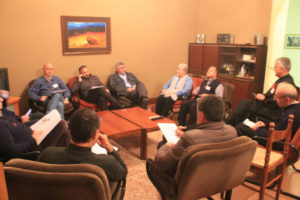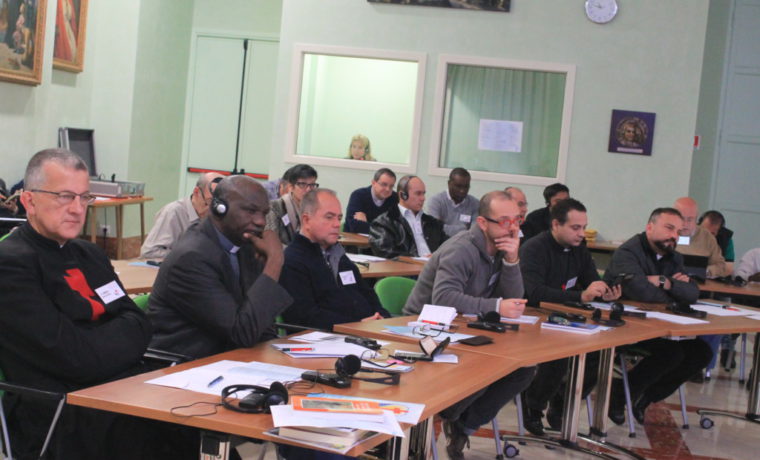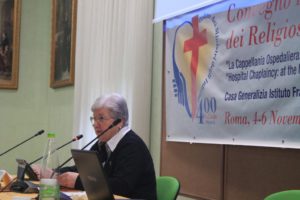RELAZIONE: Una sfida nuova e antica: le cure palliative di Laura Marotta
6 November 2016
The (third) day of the conference opened with the celebration of lauds. The chairman summarised what had been said the previous day. The floor was then given to Don Carmine Arice, the Director of the Office for Pastoral Care in Health of the Italian Bishops’ Conference, who had been invited to give a paper entitled: ‘The Universal Church and the Contribution of the Camillian Charism to the Carrying out of her Mission’.
‘Institutions on their own do not have life and do not give life. They can give life only through people who are animated by the Spirit, the giver of life’. This is how Don Arice began, emphasising that only ‘new men’ generate new life, in pastoral ministry as well, and in the ministry of pastoral care in health.
The apostolic mission of the Camillians in the Church and society, in the view of Don Arice, is characterised by the following ‘passages’: vocation to consecrated life, through the charism of the foundation and the journey of the Church, history, the social and cultural context, human and economic resources, etc.
Jesus who is amongst people who have gathered together in his name is ready to illumine the hearts of those who want to understand his teaching. If we do not manage to solve or explain problems, we address ourselves with our requests to he who is present where ‘two or three have gathered together in my name’.
The mission of the Camillians, a mission faithful to the charism of the founder, can be corroborated and understood in a better way with reference to the words that Pope Francis addressed to those taking part in the General Chapter of the Schönstatt fathers on 3 September 2015: ‘After these years on the path, you take care to keep alive the foundational charism and the ability to pass it on to the younger generations…You know that a charism is not an exhibit from a museum, which stands untouched in a display case, to be contemplated and nothing more. Fidelity to the charism, keeping it pure, in no way means enclosing it in a sealed bottle, as if it were distilled water, to prevent it from becoming contaminated by the outside. No, a charism is not preserved by keeping it aside; it must be opened and allowed to go out, so it may come into contact with reality, with people, with their anxieties and their problems. In this way, in this fruitful encounter with reality, the charism grows, is renewed and reality is also transformed, is transfigured through the spiritual power that this charism bears…it was important to keep “an ear to the heart of God and a hand on the pulse of the times”. These are the two pillars of an authentic spiritual life’.
A charismatic identity can be understood with reference to two dimensions – the itinerant and the communicant – because the charism should be read in history.
Itinerant, because the charism is not something that is static. Instead, it moves with the movement of historical events. Communicant, that is to say in dialogue with these events.
Prophecy and not the radical nature of evangelical life is specific to consecrated people. The consecrated are called to wake up the world by being ‘signs’ of the Kingdom; thus for them, and in them, the primacy of God must be emphasised. There is a need for the witness of fraternal communion in which the charism is embodied.
With respect to a charism at the service of the sick, for the Camillians it is useful to remember two figures who worked with St. Camillus, one of whom was cited by Fr. Sanzio Ciccatelli in his biography of the saint of Bucchianico: Br. Orazio Porgiano; and Father Giovanni Battista Pasquale (a ‘martyr of charity’) who lost his life because he provided care to the plague-stricken during the plague that struck Palermo. Both of them placed the sick at the centre of their lives in a fundamental and radical way.
We can now ask in which socio-cultural context the Camillians are asked to live today and which challenges they have to address to make their charism living and lively.
We know that history is constantly changing: the challenges are, therefore, the signs of this evolving history. One should never regret a past that will not return; one has to accept the present which pro-vokes (the dash is no accident) a service that is not simply philanthropic (anybody could provide it) but which also has evangelisation has an objective: bringing the ‘good news’ to the poor and the suffering.
Authoritative help comes to us from the apostolic exhortation of Pope Francis Evangelii Gaudium, the ‘programme’ for the Church according to Pope Francis himself. At numbers 54 and 55 of this document, the Pope engages in a cogent criticism of what he calls an ‘economy of exclusion’. He clearly says ‘no’ to a new idolatry of money that governs rather than serves; to unfairness that generates violence etc. This is a ‘new culture’ that impoverishes man and it is the duty of the Church to oppose it. Above all one is dealing with new cultural challenges posed by a humanity that runs the risk of forgetting about spiritual needs and transcendence.
The Pope then observes that there are many forms of discrimination and that the ‘worst discrimination which the poor suffer is the lack of spiritual care’. ‘The great majority of the poor have a special openness to the faith’, the Pope continues, ‘they need God and we must not fail to offer them his friendship, his blessing, his word, the celebration of the sacraments and a journey of growth and maturity in the faith. Our preferential option for the poor must mainly translate into a privileged and preferential religious care’ (EG, n. 200).
The task of consecrated people, and of Camillians amongst them, is to listen to the ‘cry of the poor’ which is not confined to asking for economic or social justice but which also concerns the ‘spiritual discrimination’ to which the Pope refers, a ‘subtle’ discrimination but perhaps one of the gravest. Cardinal Kasper speaks amply about this in his work ‘Mercy’.
 There are various kinds of poverty – economic poverty, cultural poverty, poverty in relation to health, and spiritual poverty. We need to face up to all these kinds of poverty, even though attention is principally paid to economic poverty. This is certainly very important in a situation of a dominant neo-free-market approach that does not aim at the common good, but, rather, at the individual good, with all the possible exclusions that this provokes.
There are various kinds of poverty – economic poverty, cultural poverty, poverty in relation to health, and spiritual poverty. We need to face up to all these kinds of poverty, even though attention is principally paid to economic poverty. This is certainly very important in a situation of a dominant neo-free-market approach that does not aim at the common good, but, rather, at the individual good, with all the possible exclusions that this provokes.
We have before us what Pope Francis has identified as the ‘throwaway culture’. We should ask ourselves which anthropology is at the base of our cultures, and of Western culture in particular. We no longer speak about ‘personalism’, we do not identify one anthropology, but, rather, a number of anthropologies which do not dialogue with each other. All of this also has an impact on care: we have passed from a medicine of needs to a medicine of desires; the new technologies seem to be able to solve everything, provoking a ‘delirium for immortality’. But a human being is mortal…
Still on the subject of poverty, certainly important today, but above all else for developing countries, is the poverty of health. But we should not forget spiritual poverty: today, a spiritual life is at times invoked with desperation because without it life does not have sense and meaning.
We could call this a ‘diagnosis of our time’. We need to go further. This can be done by being present in a com-munion, with com-passion, for com-fort. Jorge Mario Bergoglio in his address to the cardinals at the conclave before his election identified in a clear way the identikit not only of the next Pope but also of the ‘next’ Church: ‘Thinking of the next Pope: a man who, through the contemplation of Jesus Christ and the worship of Jesus Christ should help the Church to move out of herself towards the outskirts of existence; which should help her to be the fecund mother who lives ‘by the sweet and comforting joy of evangelising’’. Here we have it: the outskirts of existence must concern the Church, therefore consecrated people, therefore the Camillians.
But with a specificity for Camillians: that of being at the service of the ‘integral health’ of man, which means not only physical wellbeing (as contemporary culture tends to think) but also mental and spiritual wellbeing. We can thus say that a chaplain must be the sacrament of the presence of Christus medicus and of his Church in order to bring the light and the grace of the Lord to those who suffer.
Today the Camillian charism at the service of the whole of the community must be a setting for the promotion of the culture of life. It should be capable of saying ‘universal’ words in the world of care at the service of the culture of encounter and dialogue that should accompany with a relationship of help that is also integral. That is to say not limited (as is the tendency today) to the physical but also open to offering help to the search for the sense and meaning of life. This should lead to bringing to people’s hearts the wish that everyone will achieve encounter with Jesus Christ.
In the work of chaplains, inside a Church directed towards fringes that are not only geographical but also moral and spiritual, the poorest should be privileged. This means – and for the Camillians this is basic – dedicating oneself, for example, with affectionate and concerned care to accompanying the dying (‘were you not called once the fathers of the good death’?)
For this reason, spirituality, life in the Spirit and close ‘conversation’ with the Father in the imitation of Jesus of Nazareth, must be at the root of all activity. Let us remember that the crisis of the meaning of life is also the crisis of the meaning of religious life.
In the morning there was a meeting of those present with the Superior General of the Order, Father Leocir Pessini. This was an open and fraternal meeting during which those participants who wished to do so could pose numerous questions to the Superior General.
Father Pessini, in addition to answering the questions in a reasoned and helpful way, wanted to emphasise in particular the importance that the Camillianum can have in today’s social, cultural and spiritual-religious situation. It must be revitalised and reinvented, moving from being not only a ‘faculty of theology’ to being also a place of experimentation and research in the field of pastoral care in health. This is a task which at the present time, it appears, is not performed by anyone.
The morning ended with a celebration of the Eucharist presided over by Father Pessini. In his homily he wanted to emphasise the originality, the boldness and, at the same time, the usefulness for an analysis by religious of the life in the spirit of the placing together in the paper by Father Monks of the Good Samaritan and the Samaritan woman. Whereas the Good Samaritan is the outstanding reference point for the activity of a Camillian religious, the Samaritan woman who asks Jesus who he is, and in their conversation discovers a ‘God near as never before’, becomes an example of discipleship and life in the Spirit, a life of constant reference to the Lord.
















Camillians on Facebook
Camillians on Twitter
Camillians on Instagram